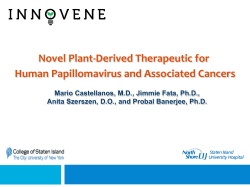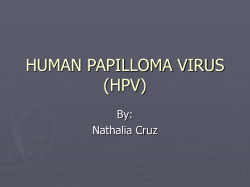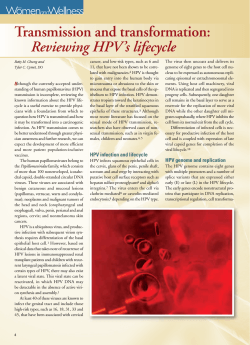
Human papillomavirus genotype prevalence and
International Journal of Research in Medical Sciences Birrou K et al. Int J Res Med Sci. 2015 Jan;3(1):95-99 www.msjonline.org pISSN 2320-6071 | eISSN 2320-6012 DOI: 10.5455/2320-6012.ijrms20150116 Research Article Human papillomavirus genotype prevalence and distribution among Moroccan women Kamal Birrou1, Mohamed Rida Tagajdid2*, Hicham El annaz1,2, Safae Elkochri2, Rachid Abi1,2, Mimoune Zouhdi1,3, Saad Mrani1,2 1 Department of Research in Molecular Virology and Onco-biology, Faculty of Medicine and Pharmacy of Rabat, Mohammed V University, Souissi, Rue Lamfadel Cherkaoui Rabat Institute, Rabat, BP-6527, Morocco 2 Laboratory of Virology, Mohammed V Teaching Military Hospital of Rabat, Rabat-10100, Morocco 3 Laboratory of Bacteriology-Virology, Ibn Sina Hospital, Rue Lamfadel Cherkaoui Rabat Institutes, Rabat, BP-6527 Morocco Received: 3 November 2014 Accepted: 3 December 2014 *Correspondence: Dr. Mohamed Rida Tagajdid, E-mail: tagajdid@laposte.net Copyright: © the author(s), publisher and licensee Medip Academy. This is an open-access article distributed under the terms of the Creative Commons Attribution Non-Commercial License, which permits unrestricted non-commercial use, distribution, and reproduction in any medium, provided the original work is properly cited. ABSTRACT Background: Human papillomavirus (HPV) is the major etiologic agent of invasive cervical cancer, vulvar and vaginal cancer. It has been estimated that, worldwide, 70% of cervical cancers are due to HPV-16 and HPV-18. Malignant transformation appears to require the presence of additional cofactors such as pregnancy, smoking and immunosuppression. The aim of the present study was to determine the prevalence and distribution of HPV genotypes among Moroccan women. Methods: Between January 1, 2011, and December 31, 2012, 277 cervical samples collected from confirmed women who attended the department of gynecology and obstetrics at Mohamed V Military teaching hospital, Rabat, Morocco, were analyzed in the laboratory of virology for HPV in vitro diagnosis and genotyping and for cytology in laboratory of pathology. Results: High-risk HPV DNA was detected in 101 (36%) samples, with higher prevalence in women ≥45 (43%) years. The overall prevalence of HPV infection and multiple infections in the study samples was 76% and 21%, respectively. The most frequent HPV genotypes were HPV-16 (31%). Human papillomavirus DNA detection was inversely related to maternal age. The risk of HPV infection was significantly reduced in women aged older than 30 years. The history of gynaecological problem showed significant association with the HPV positive test. Conclusion: In Morocco, the diagnosis of cervical lesions rests exclusively on the cytology-based screening that offers substantial protection, although current coverage is low. The introduction of HPV DNA testing in cervical cancer management will greatly benefit early stage HPV detection and help prevent development of cervical lesions and cancer. Screening pregnant women offer a significant opportunity for the Moroccan National Program against cervical cancer to control. Keywords: Human papillomavirus, Genotype, Pregnancy International Journal of Research in Medical Sciences | January 2015 | Vol 3 | Issue 1 Page 95 Birrou K et al. Int J Res Med Sci. 2015 Jan;3(1)95-99 INTRODUCTION Human papillomavirus (HPV) is the major etiologic agent of invasive cervical cancer, vulvar and vaginal cancer.1 It has been estimated that, worldwide, 70% of cervical cancers are due to HPV-16 and HPV-18.2 Malignant transformation appears to require the presence of additional cofactors such as pregnancy, smoking and immunosuppression.3 Whether pregnancy predisposes to HPV infection and/or malignant transformation is not known. A number of investigators have proposed that the physiological and hormonal changes in pregnancy may modulate immune function leading to changes in the behavior of HPV infection.4 In Morocco, published statistics showed that cervical cancer represents a serious public health problem and in the absence of a national cancer registry, data are limited to the number of cases registered in some medical centres. The hospital-based cancer registry of the National Institute of Oncology (INO), Rabat, reports more than 500 new cases annually. 2 The aim of the present study was to determine the prevalence and distribution of HPV genotypes among Moroccan women. METHODS Between January 1, 2011, and December 31, 2012, 277 cervical samples collected from women who attended the department of gynecology and obstetrics at Mohamed V Military teaching hospital, Rabat, Morocco, were analyzed in the laboratory of virology for HPV in vitro diagnosis and genotyping. Subjects were excluded if they had evidence of immunosuppression or were receiving medications related to immune modulation (such as corticosteroids). Each participant completed a comprehensive medical history questionnaire, which included questions about sociodemographic characteristics, smoking, drinking, reproductive and sexual history, and use of contraception. The cervical swab samples were solubilized in a fluid medium (ThinPrep; Cytyc, Boxborough, MA, USA) and stored at −20 °C until DNA purification. Papanicolaou testing was used to detect cytologic anomalies, as defined by the Bethesda 2001 guidelines.5 All cervical samples were also tested for HPV DNA detection and typing by the INNO-LiPA HPV Genotyping Extra assay (Innogenetics, Les Ulis, France) according to the manufacturer’s instruction. This test allows the detection of HPV types 6, 11, 16, 18, 26, 31, 33, 35, 39, 40, 43, 44, 45, 51, 52, 53, 54, 56, 58, 59, 66, 68, 69, 71, 73, 70, 74, and 82. High- and low-risk HPV were classified according to the consensus of the International Agency for Research on Cancer (IARC).6 Statistical analysis was performed with SPSS 10.0 (SPSS, Chicago, IL, USA) and Epi Info 3.5.1 (Centers for Disease Control and Prevention, Atlanta, GA, USA). Intergroup differences were assessed via t and χ2 tests. Data are expressed as the percentages of the mean or as genotype frequencies. Statistical significance was defined as P <0.05b. RESULTS The characteristics of the study population are reported in Table 1. The mean age of women was 46 with extreme ages at 25 to 65 years. More than 70% lived in an urban area, most frequently in Rabat. The majority of the participants reported one lifetime sexual partner. A history of contraceptive use was reported by about 55% of women, including 20% using an intrauterine device and 35% using an oral contraceptive. Three women reported family neoplasia history (breast and digestive tracts) and 50% of participating women had never had a Pap test for cervical lesion diagnosis. Table 1: Characteristics of the study population. Total Age 25-29 30-44 ≥ 45 Partner Unique Multiple Parity Less than 3 children 3 children or more Contraception Intrauterine Oral contraception No Polyps, Cervicitis, fibroma, others Yes No Pap Smear Never ≥1 277 % 87 127 63 31.4 45.8 22.7 250 27 90 10 127 150 55 45 57 97 123 20 35 45 37 240 13 87 137 140 49.5 50.5 High-risk HPV DNA was detected in 91 (32%) samples, with higher prevalence in women ≥45 years. Of the 277 study subjects, 189 (68%) had normal Papanicolaou smear results, 25 (10%) had atypical squamous cells of undetermined significance, 22 (7%) had low-grade squamous intraepithelial lesions and 4 (1.5%) had highgrade squamous intraepithelial lesions. All women with abnormal cytological findings underwent colposcopic examinations and biopsies. Of these, 69 had chronic cervicitis, 10 had mild dysplasia [cervical intraepithelial neoplasia, grade I (CIN I)] and one had severe dysplasia (CIN III). None had invasive cervical cancer. International Journal of Research in Medical Sciences | January 2015 | Vol 3 | Issue 1 Page 96 Birrou K et al. Int J Res Med Sci. 2015 Jan;3(1)95-99 The overall prevalence of HPV infection and multiple infections in the study samples was 76% and 21%, respectively. The most frequent HPV genotypes were HPV-16 (31%) and HPV-18 (20%). Among women with normal cytologic findings, the prevalence of HPV infection was 36%. Among women with pathologic findings, the prevalence of HPV infection was significantly higher (36%) (Table 2). Table 2: Distribution of HPV genotype according to the cytological results. Normal Abnormal INS ASC-US LSIL HSIL Total No. (%) HPV+ 189(68) 88(32) 37(13) 25(10) 22(7) 4(1.5) 277 69(36.5) 32(36) 10(27) 9(36) 10(45) 3(75) 101 HPV 6 HPV 11 HPV 16 HPV 18 HPV 31 HPV 33 HPV 35 HPV 45 HPV 16+18 1 0 4 1 1 27 2 17 3 0 1 1 2 1 1 1 0 7 5 2 1 1 1 5 3 1 1 1 1 2 2 1 HPV 16+18+ others 4 7 2 3 1 1 Other HPV 1 8 4 2 2 INS: No specific inflammation; ASCUS: Atypical squamous cell with indeterminated signification; LSIL: Low grade squamous intraepithelial lesions; HSIL: High grade squamous intraepithelial lesions Statistical analysis showed that history of gynaecological problems showed a significant association (P = 0.0206). The other risk factors did not show any significant association in the population study. DISCUSSION In Morocco, cervical cancer is the second most frequent female cancer after breast cancer and represents a major public health problem. The diagnosis is usually made in advanced stages, and mortality is high. A global epidemiologic study conducted by the International Agency for Research on Cancer showed that HPV prevalence is very different between countries. Lower prevalence was found in Europe (10.5%)\and intermediate prevalence was found in South America (14.3%), whereas the highest prevalence was found in Africa (25.6%). Moreover, similar results were found in other countries such as India (18.8%), Venezuela (15.6%) and Algeria (12.5%).7 Among the high-risk HPV genotypes, infection with HPV 16 or 18 is seen most commonly. Most HPV infections in young women are temporary and have little long-term significance. Indeed, 70% of genital HPV infections are cleared within 1 year and 90% are cleared in 2 years. It is widely accepted that in addition to HPV infection, other cofactors could have a great role in the development of cervical lesions. These factors may be classified into two groups: 1. environmental or exogenous cofactors, including the use of oral contraceptives (OCs), tobacco smoking, diet, cervical trauma, and co-infection with human immunodeficiency virus (HIV) and other sexually transmitted agents; 2. host cofactors, including endogenous hormones, genetic factors such as human leukocyte antigen, and other host factors related to the host’s immune response.10-16 In the current study, due to limited data, only risk factors related to age, socioeconomic level, sexual activity, oral contraception, and family situation were examined. In this study, the only statistically significant association was found between HPV infection and oral contraceptive use. In the present study, multiple HPV infections were observed in only 21% of the HPV-positive specimens. A previous study on Moroccan cervical cancer specimens found multiple infections in 35.4% of specimens.11 HPV cannot be grown in culture and detection of the virus relies on a variety of techniques used in immunology, serology, and molecular biology. Presently, the two assays most widely used for the detection of genital types are PCR with generic primers and the Hybrid Capture 2 assay (Digene Corp, Gaithersburg, MD, USA). The PCR-based assay is based on target amplification and care must be taken to avoid contamination. Its advantage is that it allows identification of different types of HPV and can discriminate between multiple infections. However, it is expensive, time-consuming and laborious and essentially a research tool, not suited to be applied as a mass screening test. However, HPV testing is currently more expensive than other screening tests and requires sophisticated laboratory infrastructure that includes testing equipment, storage facilities for samples, and trained technicians. Meta-analysis of studies from the United Kingdom (HART, Hammersmith), France (Reims), Germany International Journal of Research in Medical Sciences | January 2015 | Vol 3 | Issue 1 Page 97 Birrou K et al. Int J Res Med Sci. 2015 Jan;3(1)95-99 (Hannover and Tuebingen, Jena), the Netherlands (Amsterdam) and Canada found that the sensitivity for detection of CIN 2+ disease by HPV testing was 96 per cent and by cytology was 53 per cent, while the specificity was 92 and 97 per cent respectively.10 Ethical approval: The study was approved by the institutional ethics committee REFERENCES 1. In addition, testing for high-risk types of HPV DNA (hrHPV) has a very high negative predictive value (NPV), with most studies reporting values greater than 99 per cent and some reporting 100 per cent.11 The high NPV for hrHPV has important implications for screening programs. First, screening intervals may be significantly increased in women older than 30 year who have tested negative hrHPV as the risk of these women developing cervical cancer over a 5- to 8-year period is negligible. Secondly, when combining HPV DNA testing with cytologic testing, women who test negative with both methods may receive a very high level of reassurance that they will not be at risk for cervical cancer for a long time, perhaps the next 10 years. The advantages of HPV DNA testing as a screening test compared with cytologic evaluation or visual inspection of the cervix are as follows: (i) Its higher sensitivity is particularly important in settings where women will be screened only once or twice in their lifetimes. This has been seen with the new, rapid HPV test as well.12 (ii) HPV DNA testing not only identifies women with cervical disease but also those at risk for developing CIN within the next 3 to 10 years. This is particularly important for developing countries that might not have sufficient resources to screen all women at 5- to 10-year intervals, but might have the resources to screen a small subset of high-risk HPV DNA-positive women at more frequent intervals. (iii) The interpretation of the test is objective and does not have the inherent subjectivity of visual screening methods or cervical cytology. In developing countries, rates of HPV DNA positivity in women older than 30 year vary from 6 to 18 per cent.12,15,16 Therefore HPV screening should be initiated after the age of 30 year in order to exclude transient positive cases. In Morocco, the diagnosis of cervical lesions rests exclusively on the cytology-based screening that offers substantial protection, although current coverage is low. The introduction of HPV DNA testing in cervical cancer management will greatly benefit early stage HPV detection and help prevent development of cervical lesions and cancer. Screening pregnant women offer a significant opportunity for the Moroccan National Program against cervical cancer to control. Further studies should be followed to confirm this specific pattern of HPV infections, and to estimate the impact of HPV infections during the pregnant period and thereafter. Funding: No funding sources Conflict of interest: None declared Roberts CC, Tadesse AS, Sands J, Halvorsen T, Schofield TL, Dalen A, et al. Detection of HPV in Norwegian cervical biopsy specimens with typespecific PCR and reverse line blot assays. J Clin Virol. 2006;36:277-82. 2. Amrani M, Lalaoui K, El Mzibri M, Lazo P, Belabbas MA. Molecular detection of human papillomavirus in 594 uterine cervix samples from Moroccan women (147 biopsies and 447 swabs). J Clin Virol. 2003;27:286-95. 3. Kim YH, Park JS, Norwitz ER, Park JW, Kim SM, Lee SM, et al. Genotypic prevalence of human papillomavirus infection during normal pregnancy: a cross-sectional study. J Obstet Gynecol Res. 2014;(4):200-7. 4. Fife KH, Katz BP, Brizendine EJ, Brown DR. Cervical human papillomavirus deoxyribonucleic acid persists throughout pregnancy and decreases in the postpartum period. Am J Obstet Gynecol 1999;180:1110-4. 5. Solomon D, Davey D, Kurman R, Moriarty A, O'Connor D, Prey M, et al. The 2001 Bethesda system: terminology for reporting results of cervical cytology. JAMA. 2002;287:2114-9. 6. Bouvard V, Baan R, Straif K, Grosse Y, Secretan B, El Ghissassi F, et al. A review of human carcinogens: Part B: biological agents. Lancet Oncol. 2009;10:321-2. 7. Allhamany Z, El Mzibri M, Kharbach A, Malihy A, Abouqal R, Jaddi H, et al. Prevalence of human papillomavirus genotype among Moroccan women during a local screening program. J Infect Dev Ctries. 2010;4(11):732-9. 8. Hernandez-Giron C, Smith JS, Lorincz A, Lazcano E, Hernandez-Avila M, Salmeron J. High-risk human papillomavirus detection and related risk factors among pregnant and non-pregnant women in Mexico. Sex Transm Dis. 2005;32:613-8. 9. Aydin Y, Atis A, Tutuman T, Goker N. Prevalence of human papilloma virus infection in pregnant Turkish women compared with non-pregnant women. Eur J Gynecol Oncol. 2010;31:72-4. 10. Castellsague X, Muñoz N. Cofactors in human papillomavirus carcinogenesis-role of parity, oral contraceptives, and tobacco smoking. J Natl Cancer Inst Monogr. 2003;31:20-8. 11. Khair MM, Mzibri ME, Mhand RA, Benider A, Benchekroun N, Fahime EM, et al. Molecular detection and genotyping of human papillomavirus in cervical carcinoma biopsies in an area of high incidence of cancer from Moroccan women. J Med Virol. 2009;81:678-84. 12. Domza G, Gudleviciene Z, Didziapetriene J, Valuckas KP, Kazbariene B, Drasutiene G. Human International Journal of Research in Medical Sciences | January 2015 | Vol 3 | Issue 1 Page 98 Birrou K et al. Int J Res Med Sci. 2015 Jan;3(1)95-99 papillomavirus infection in pregnant women. Arch Gynecol Obstet. 2011;284:1105-12. 13. Tamalet C, Le Retraite L, Leandri F, Heid P, Sancho Garnier H, Piana. Vaginal self-sampling is an adequate means of screening HR-HPV types in women not participating in regular cervical cancer screening. Clin Microbiol Infect. 2013;19:E44-50. 14. Tenti P, Zappatore R, Migliora P, Spinillo A, Maccarini U, De Benedittis M, et al. Latent human papillomavirus infection in pregnant women at term: a case-control study. J Infect Dis. 1997;176:277-80. 15. Wright TJ, Denny L, Kuhn L, Pollack A, Lorincz A. HPV DNA testing of self-collected vaginal samples compared with cytologic screening to detect cervical cancer. JAMA. 2000;283:81-6. 16. Wright T, Cox T, Stewart Massad L, Twiggs L, Wilkinson E. Consensus guidelines for the management of women with cervical cytological abnormalities. JAMA. 2002;287:2120-9. DOI: 10.5455/2320-6012.ijrms20150116 Cite this article as: Birrou K, Tagajdid MR, El annaz H, Elkochri S, Abi R, Zouhdi M, Mrani S. Human papillomavirus genotype prevalence and distribution among Moroccan women. Int J Res Med Sci 2015;3:95-9. International Journal of Research in Medical Sciences | January 2015 | Vol 3 | Issue 1 Page 99
© Copyright 2025









